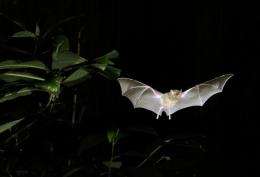February 18, 2010 report
Drunk Bats Manage To Pass Sobriety Tests

(PhysOrg.com) -- New World Leaf-nosed bats (Chiroptera Phyllostomidae) are thriving in the tropical forests of Central and South America, even though their diets consist of more fruits and nectars than their counterparts in the Old World. Strange thing is the phyllostomide bats are drawn to fruits and nectars even after they have fermented.
Bat researchers from the biology departments of the University of Western Ontario and the University of Regina (Saskatchewan, Ca) theorized that the amount of ethanol in the fermented fruit and nectars that the bats ingested was likely to induce intoxication.
The researchers gave “sobriety tests” to 106 bats, representing six species of New World Leaf-nosed bats, after the bats had consumed enough ethanol to bring their blood alcohol content (BAC) up to 0.3 or higher. (The legal limit of BAC for human drivers is .08!) The bat BAC levels were attained by feeding the test bats ethanol mixed with sugar water. Their control group counterparts received just the plain sugar water.
The bats took flight in a researcher-constructed obstacle course in which the bats would have to navigate according to five standard identifiable flying behaviors of phyllostomide bats. Otherwise, they would betray their drunkenness.
Additionally, the biologists expected the alcohol to alter the bats' echolation, or calling behavior, so they recorded the bats with ultrasonic condenser microphones.
"We went into the study fully expecting that some of the species wouldn’t be able to hold their drink," study co-author Brock Fenton, from the University of Western Ontario, told National Geographic News.
But once the bats went through the test - some, mind you, with three times higher BAC than a drunk driver - the researchers found no measurable change in either flight or calling behaviors.
A prior study conducted with Old World bats dieting on seasonal fruit and nectar reported signs that bat motor skills and echolation were clearly affected by the ethanol content in their diets. Apparently, the New World bats, exposed to high-ethanol products all year round, have developed an alcohol tolerance that has “afforded them an evolutionary edge.”
Fenton and his colleagues are now trying “to find a company that sells alcoholic refreshments who will sponsor an expanded study.”
More information: Drinking and Flying: Does Alcohol Consumption Affect the Flight and Echolocation Performance of Phyllostomid Bats? Citation: Orbach DN, Veselka N, Dzal Y, Lazure L, Fenton MB (2010) Drinking and Flying: Does Alcohol Consumption Affect the Flight and Echolocation Performance of Phyllostomid Bats? PLoS ONE 5(2): e8993. doi:10.1371/journal.pone.0008993
© 2010 PhysOrg.com















